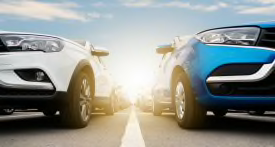New product rollouts from Dodge have been pretty scarce lately. So much so that the Hornet is Dodge’s first all-new model in almost a decade. But given just how long this Stellantis division took to unleash the Hornet and the mediocre performance it turned in during our testing, we think perhaps this model could have spent more time in the hive to bring a better A-game. You see, the number of strong small-SUV competitors is vast, and the market likely won’t tolerate a model that rides stiffly, has a loud and plastic-y cabin, and delivers just so-so fuel economy.
For background: The Hornet is built in Italy along with its sister vehicle, the Alfa Romeo Tonale, both of which are based on the aging Jeep Compass platform.
Give Dodge props for injecting the Hornet with some vigorous power in such a small package. Thanks to a 268-horsepower, turbocharged four-cylinder engine that packs a venomous midrange punch, it flew from 0 to 60 mph in a quick-for-its-class 6.4 seconds. But that power comes at a cost. A combination of turbo lag and the way the nine-speed automatic transmission often ends up confused about which gear to be in results in low-speed hiccups and power delays. Yes, the sting looks good on paper, but the Hornet isn’t all that fun to drive every day.
It also isn’t a very efficient machine. The 23 mpg overall it managed in our testing is below average for the class.
Plus, the chassis struggles to handle the abundant torque the Hornet possesses, which can cause the steering wheel to tug back and forth in your hands when accelerating hard. One popular misconception in the car world is that a stiff suspension results in precise handling: You might be willing to put up with a brutal ride if the car is super satisfying on a curvy road (i.e. Subaru WRX). And yes, the Hornet’s suspension beats you up over bumps, and jostles passengers back and forth. Yet it doesn’t reward that compromise with confident handling. There’s little body roll, but the rubbery steering feels artificially heavy and conveys hardly any feedback to the driver.
Further exacerbating the driving experience is that the cabin stays nearly unrelentingly loud, suffering from excessive wind and road noise on the highway. And despite its Italian lineage, the Hornet’s engine doesn’t sing a very sweet song.
All-in-all, this Hornet just doesn’t fly.
Inside the cabin, our testers found that our GT model’s limited seat adjustments produced a compromised driving position. Other impediments to getting comfortable behind the wheel included a left footrest that’s too close to the driver which can leave you with tightly bent knees and outstretched arms. At least there are well-placed armrests and decent headroom (note that the optional sunroof makes headroom tight for taller drivers).
The seats themselves came with no lumbar support adjustment, but they are really well-shaped with plenty of lateral support to help hold you in place through corners. Unfortunately, not all body types will fit into this narrow seat, which resulted in many of our drivers looking to bail out of this car after just a two-hour drive. The rear seat has limited headroom, but there’s good knee room and ample foot space under the front seats. But the seat’s flat shape and upright seatback (which can’t be reclined) mean it’s not all that comfortable of a place to spend time.
The controls were a decidedly mixed bag. The infotainment screen is nicely designed, but the icons and text are small, and can be hard to decipher and press while driving. We noticed that the center screen suffers from noticeable lag, especially when switching between menus—such as jumping between displaying a playlist and the navigation screen. We appreciated that most of the climate controls are physical buttons, but we were equally annoyed that we had to delve into the center screen to make adjustments to the seat heaters and to sync the automatic climate system to equal the temperatures for both the front passenger and driver.
We tempered our expectations when it came to the Hornet’s interior finish: By and large, this isn’t an expensive car. So, we were pleased to see a few classy details, such as the red stitching on the door and center armrests, and across the mid-dash. But it’s impossible to ignore that the cabin is surrounded by a sea of hard plastics. We also found several exposed mold lines, sharp edges here and there, and indifferent panel gaps.
The Hornet is a pretty narrow SUV, which limits cargo space compared to competing models by a significant margin.
The Hornet comes standard with automatic emergency braking with pedestrian, bicyclist, and motorcycle detection, automatic emergency braking that operates at highway speeds, blind spot warning, rear cross traffic warning, lane departure warning, lane keeping assistance, adaptive cruise control, and automatic high beams.



















